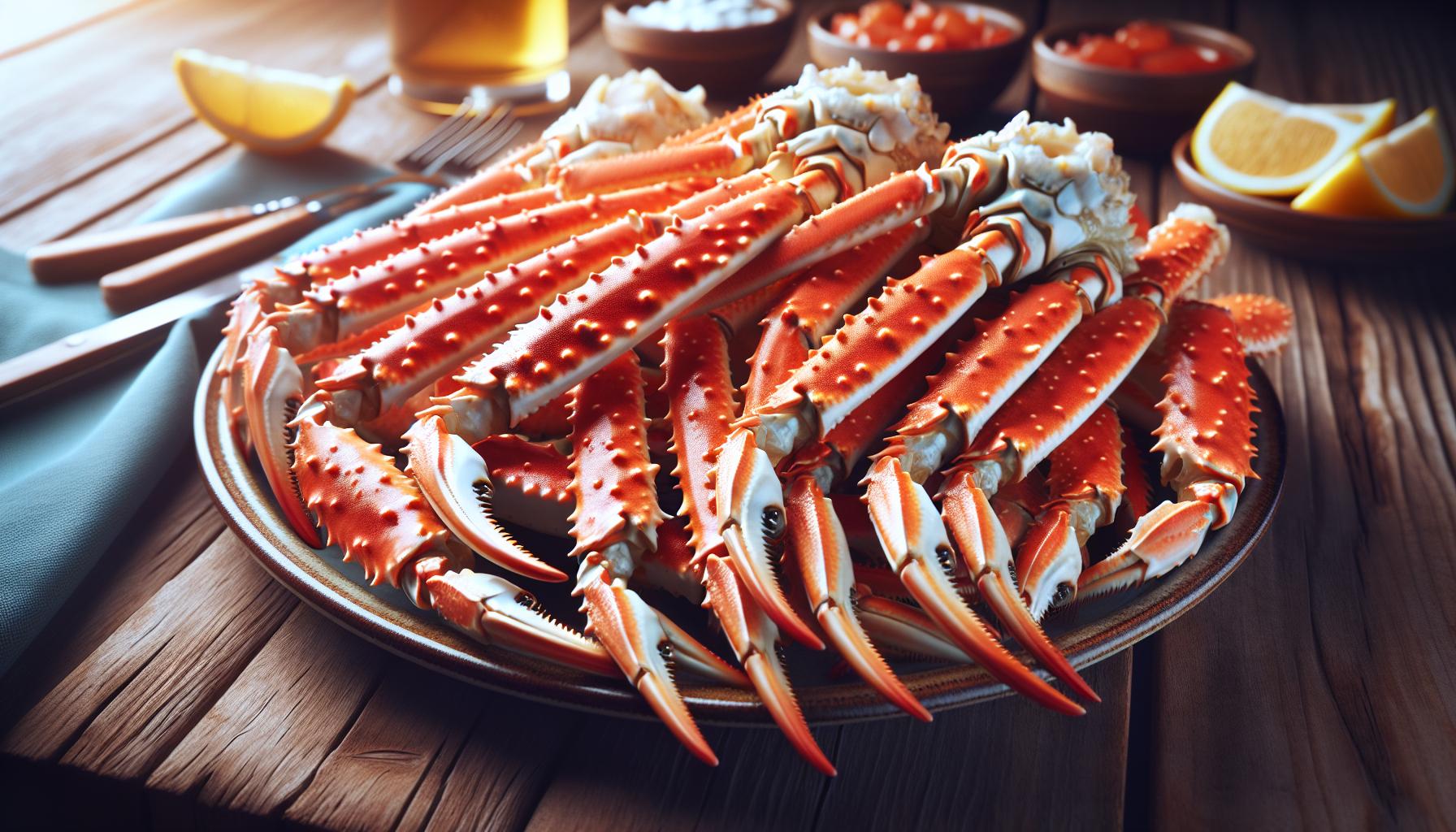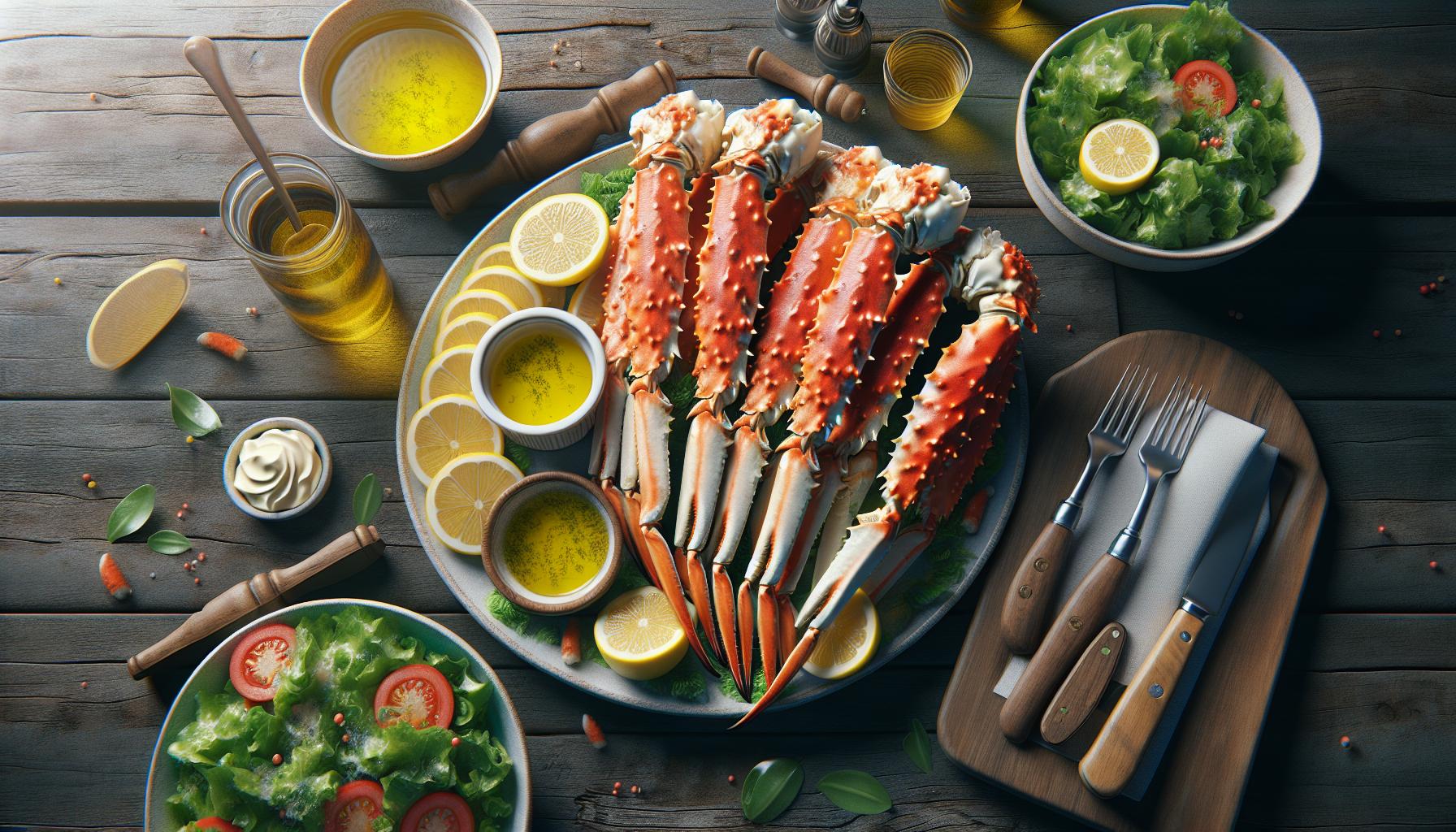Craving those succulent snow crab legs but wondering about their nutritional value? These oceanic delicacies aren’t just a treat for your taste buds – they’re packed with essential nutrients that can elevate your dining experience to a whole new level of healthy indulgence.
One pound of snow crab legs delivers an impressive array of nutrients while keeping calories in check. Whether you’re a seafood enthusiast or a health-conscious foodie these crustacean delights offer a perfect blend of protein minerals and omega-3 fatty acids. It’s time to discover why these sweet tender morsels from the cold waters of the North Pacific have become a favorite among nutrition-savvy diners worldwide.
1 lb Snow Crab Legs Nutrition Facts
Snow crab legs come from the Chionoecetes opilio species, a crustacean found in cold northern waters. These crabs earn their name from their bright white meat that resembles snow when cooked.
Physical Characteristics
Snow crabs feature long spindly legs with a distinctive orange-red shell exterior contrasting with pure white meat inside. The legs measure 2-3 feet in span when fully extended from the body. Male snow crabs grow larger than females, reaching weights up to 3 pounds with a shell diameter of 6 inches. Their shells display a granular texture with small spines across the surface. The meat inside maintains a sweet delicate flavor with a tender fibrous texture that separates easily into neat segments.
Habitat and Harvesting
Snow crabs thrive in the deep cold waters of the North Atlantic Ocean Pacific Ocean with depths ranging from 65 to 1,150 feet. Commercial fishing operations harvest these crustaceans primarily in Alaska’s Bering Sea Canadian Maritime waters. Fishing vessels use specialized crab pots dropped to the ocean floor during peak seasons from January through March. After capture, processors sort grade clean the crabs before flash-freezing them to preserve freshness. Sustainable harvesting practices regulate catch limits ensure healthy population levels with most snow crab fisheries maintaining MSC certification for responsible management.
Nutritional Value of 1 Pound Snow Crab Legs

One pound of snow crab legs delivers premium nutrition with minimal calories. The meat inside these delicate shells provides essential nutrients that support overall health.
Calories and Macronutrients
A pound of snow crab legs contains 480 calories with exceptional protein content. The nutritional breakdown includes:
| Nutrient | Amount per 1 lb |
|---|---|
| Protein | 82g |
| Total Fat | 11g |
| Saturated Fat | 1g |
| Cholesterol | 180mg |
| Carbohydrates | 0g |
| Sodium | 2400mg |
The high protein content supports muscle maintenance while the low fat content makes it ideal for calorie conscious diets. Snow crab legs contain zero carbohydrates making them compatible with ketogenic dietary patterns.
Vitamins and Minerals
Snow crab legs pack an impressive array of essential minerals and vitamins:
| Nutrient | Amount per 1 lb |
|---|---|
| Zinc | 10.2mg |
| Selenium | 85mcg |
| Vitamin B12 | 11.5mcg |
| Copper | 1.6mg |
| Phosphorus | 460mg |
| Iron | 5.4mg |
The selenium content supports thyroid function while zinc enhances immune system response. High vitamin B12 levels promote red blood cell formation. The copper content aids in collagen production for healthy skin and joints.
Health Benefits of Snow Crab Meat

Snow crab meat offers significant nutritional advantages through its dense protein content and essential nutrients. These benefits contribute to overall wellness through multiple biological pathways.
Heart Health Benefits
Snow crab meat promotes cardiovascular health through its omega-3 fatty acid content. The meat contains EPA (eicosapentaenoic acid) and DHA (docosahexaenoic acid), which reduce inflammation in blood vessels. Regular consumption of snow crab meat helps maintain healthy cholesterol levels by increasing HDL (good) cholesterol while lowering LDL (bad) cholesterol. The high potassium content in snow crab meat regulates blood pressure by counteracting sodium’s effects. Research indicates that consuming 3-4 ounces of snow crab meat twice weekly supports optimal heart function.
Muscle and Bone Support
Snow crab meat strengthens muscles and bones through its complete protein profile containing all nine essential amino acids. The meat provides 82 grams of protein per pound, supporting muscle repair and growth after physical activity. Its calcium content of 135mg per serving reinforces bone density and prevents mineral loss. The combination of vitamin D and phosphorus in snow crab meat enhances calcium absorption for stronger skeletal structure. Zinc content aids in collagen formation, maintaining joint flexibility and promoting tissue repair.
How to Select and Store Snow Crab Legs

Fresh snow crab legs display specific characteristics that indicate their quality and proper handling. Selecting premium snow crab legs guarantees optimal nutritional benefits and flavor.
Quality Indicators
Quality snow crab legs exhibit a bright orange-red shell color without dark spots or discoloration. The shells remain firm with minimal cracking or damage. Fresh legs emit a mild, sweet ocean scent rather than a strong fishy odor. The leg joints flex easily when bent while frozen legs break cleanly at the joints. The meat inside fills the shell completely with no separation or gaps. Pre-cooked legs show white meat with no gray or yellow discoloration. Legs feel heavy for their size, indicating proper meat content. Premium snow crab clusters maintain intact connections between leg segments.
Proper Storage Methods
Raw snow crab legs stay fresh for 24 hours in the refrigerator at 40°F wrapped in damp paper towels inside an airtight container. Frozen legs maintain quality for 6 months at 0°F in vacuum-sealed packaging or freezer bags with excess air removed. Thawed legs require immediate cooking within 24 hours. Cooked legs last 3-5 days refrigerated in sealed containers. Freezer storage prevents freezer burn by double-wrapping legs in plastic wrap then aluminum foil. Commercially frozen legs remain safe indefinitely at consistent freezing temperatures though quality declines after 6 months. Labels on packages track storage dates for optimal consumption timing.
Cooking Methods and Serving Size
Snow crab legs require precise cooking times to preserve their delicate flavor profile. These methods maximize the nutritional value while maintaining the meat’s tender texture.
Steaming and Boiling Tips
Steaming preserves the nutritional content of snow crab legs most effectively. Place a steaming rack 2-3 inches above boiling water in a large pot. Steam frozen legs for 6-8 minutes or thawed legs for 4-5 minutes until the shell turns bright red. Boiling offers an alternative cooking method: add legs to salted water at a rolling boil for 5-7 minutes. Test doneness by cutting through a leg joint – the meat appears opaque white when fully cooked. Both methods lock in essential nutrients like protein omega-3 fatty acids.
Portioning Guidelines
One pound of snow crab legs yields 4-5 ounces of pure meat. A single serving equals 4-6 legs or approximately 4 ounces of meat. Adults consume 6-8 legs per meal for optimal protein intake of 20-25 grams. Restaurant portions typically include 1-1.5 pounds of legs per guest. The meat extracts easily from pre-scored shells using seafood crackers or kitchen scissors. Each cluster contains 25-30% pure meat by weight ratio.
Exceptional Health Benefits
Snow crab legs stand out as a nutritional powerhouse that offers exceptional health benefits while keeping calories in check. Their impressive protein content combined with essential nutrients makes them an excellent choice for health-conscious seafood lovers.
Anyone looking to enhance their diet with lean protein rich in omega-3 fatty acids and vital minerals should consider adding snow crab legs to their menu. With proper selection storage and cooking techniques these delectable treasures from the sea can be a valuable addition to a balanced diet.
Remember that sustainable harvesting practices help ensure these nutritious delicacies remain available for future generations to enjoy. Whether steamed or boiled snow crab legs deliver both exceptional taste and remarkable nutritional value.



